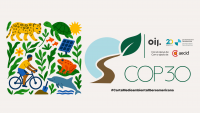Countries must invest at least 1% more of GDP on primary health care to eliminate glaring coverage gaps
 At current rates of progress, up to 5 billion people will miss out on health care in 2030. Countries must increase spending on primary healthcare by at least 1% of their gross domestic product (GDP) if the world is to close glaring coverage gaps and meet health targets agreed in 2015, says a new report from the World Health Organization and partners on the eve of a UN General Assembly high-level meeting on Universal Health Coverage. They must also intensify efforts to expand services countrywide.
At current rates of progress, up to 5 billion people will miss out on health care in 2030. Countries must increase spending on primary healthcare by at least 1% of their gross domestic product (GDP) if the world is to close glaring coverage gaps and meet health targets agreed in 2015, says a new report from the World Health Organization and partners on the eve of a UN General Assembly high-level meeting on Universal Health Coverage. They must also intensify efforts to expand services countrywide.
The world will need to double health coverage between now and 2030, according to the Universal Health Coverage Monitoring Report. It warns that if current trends continue, up to 5 billion people will still be unable to access health care in this data – the deadline world leaders have set for achieving universal health coverage. Most of those people are poor and already disadvantaged.
Primary health care key to health for all
“If we are really serious about achieving universal health coverage and improving people’s lives, we must get serious about primary health care,” says Dr Tedros Adhanom Ghebreyesus, WHO Director-General. “That means providing essential health services like immunization, antenatal care, healthy lifestyle advice as close to home as possible – and making sure people do not have to pay for this care out of their own pockets.”
Investing an additional USD200 billion a year on scaling up primary health care across low and middle-income countries would potentially save 60 million lives, increase average life expectancy by 3.7 years by 2030, and contribute significantly to socio-economic development. It would represent about 3% increase on the USD7.5 trillion already spent on health globally each year.
Most of that funding would come from countries themselves. The report says that most countries can scale up primary health care using domestic resources – either by increasing public spending on health in general, or by reallocating spending towards primary health care – or by doing both. At present, most countries are underinvesting in primary health care.
But for the poorest countries, including many affected by conflict, this may not be feasible. These countries will continue to require assistance from outside. This funding must be carefully targeted to result in a lasting improvement to health systems and services – via a systematic strengthening of primary health care countrywide.
Accelerate scale-up of services
Countries must also renew efforts to scale up service coverage countrywide. Although coverage has increased steadily since 2000, progress has slowed down in recent years. Most increases have occurred in lower income countries, but these countries are still lagging behind. The biggest health service gaps are in the poorest countries and those affected by conflict.
“Too many women and children continue to die from easily preventable and treatable causes simply because they can’t get the care they need to survive,” said Henrietta Fore, UNICEF Executive Director. “By working with communities to provide primary health care to the poorest and the most vulnerable, we can reach the last mile and save millions of lives.”
Coverage is generally lower in rural areas than in towns. The report cites lack of health infrastructure, shortages of health workers, weak supply systems, and poor-quality care leading to low trust among communities as major obstacles to achieving UHC.
“Improving and expanding primary health care in all regions is key,” says Natalia Kanem, Executive Director of UNFPA. “It’s the best way to ensure people can obtain services to cover the majority of their health needs from pre-birth throughout their lives". The report also highlights the need to protect people from financial hardship.
Protecting against financial hardship
“The goal of universal health coverage will remain elusive unless countries take urgent steps to protect people from falling into poverty to pay for essential health care,” says Dr. Muhammad Pate, Global Director, Health, Nutrition, and Population at the World Bank. “Expanding access to quality primary health care services will save more lives and keep health care costs affordable.”
More people are suffering the consequences of paying for services out of their own pockets than 15 years ago. About 925 million people spend more than 10% of their household income on healthcare; 200 million people spend more than 25% of their income on health. And impoverishment due to paying for health care increased except among the extremely poor. “It’s shocking to see a growing proportion of the population struggling to make ends meet because they are paying too much for their own health, even in advanced economies” adds Angel Gurria, Secretary General of the OECD. “The only places where this is not happening is in countries that invest more and more effectively in health", she finished.
Today, 23 September, world leaders will discuss a far-reaching Declaration on Universal Health Coverage. The Declaration lists a number of steps to advance progress towards UHC. These include WHO’s recommendations relating to primary health care, including the allocation of an additional 1% GDP to primary health care through additional investments or reallocation.
The report
The Universal Health Coverage Global Monitoring Report 2019 has been prepared by the WHO, with contributions from the World Bank, the Organisation for Economic Co-operation and Development, the United Nations Population Fund, and UNICEF.
Chapter 2 of the report builds on the Joint WHO & World Bank 2019 global monitoring on financial protection. The joint report establishes global and regional 2015 baselines for indicators of catastrophic and impoverishing health spending and infers from previous trends the challenges to come in protecting people from the financial consequences of paying out of pocket for the health services they need.



